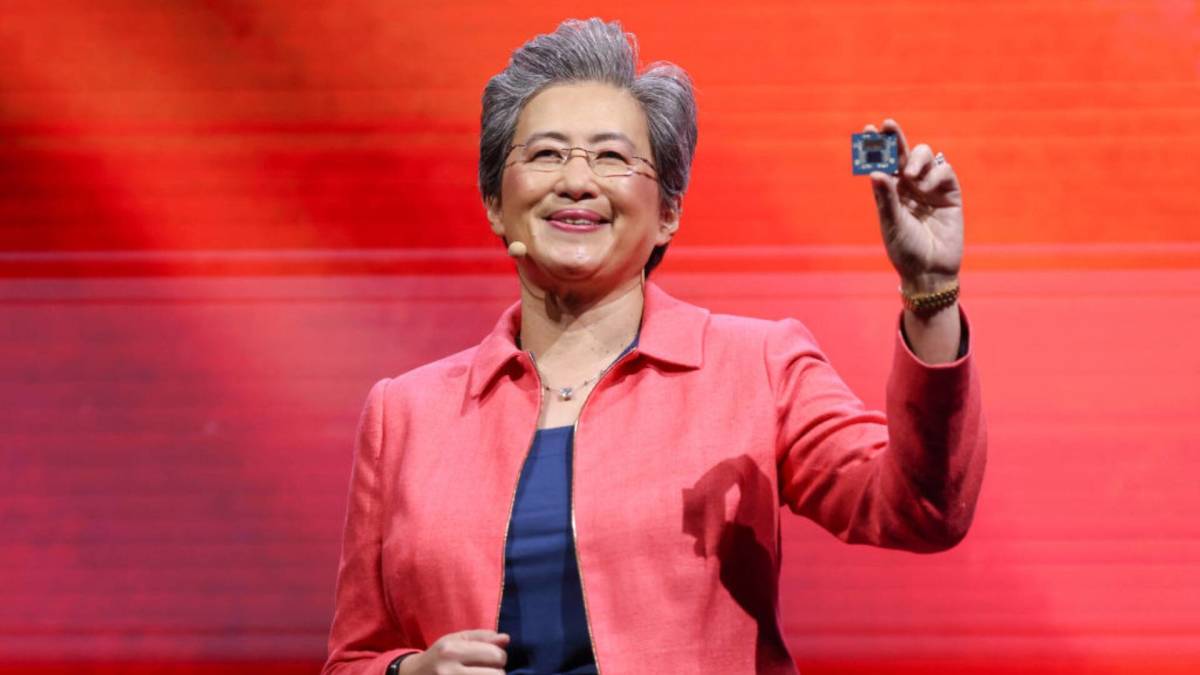Nobody needs to update their PCs or laptops, but hope has sprung eternal that demand for AMD CPUs used in PCs and laptops doesn’t matter because CEO Lisa Su is laser-focused on dislodging market share from AI chip kingpin Nvidia.
Maybe not.
AMD’s latest financial results were solid, given that the company beat analysts’ estimates on the top line. But the beat wasn’t because of surging AI demand at Nvidia’s expense. Instead, it was because of good old-fashioned CPU server demand and GPU sales for gaming.
??Don’t miss the move: Subscribe to TheStreet’s free daily newsletter??
That poses a big problem for the company and its investors, given shareholders have been arguing for a year that the real reason to buy AMD isn’t because of its legacy chips, but for its next-gen chips designed to accelerate artificial intelligence training and inference.

Image source: Cheng/AFP via Getty Images
AMD delivers the goods, with a big AI asterisk
Make no mistake, the second quarter was a good quarter for AMD. The semiconductor chipmaker, which has locked horns with Nvidia for decades, battling for market share in gaming and Intel in powering PCs, reported better-than-hoped revenue and earnings per share, or EPS.
Second quarter revenue clocked in at $7.68 billion, up 32% from last year and better than Wall Street analysts’ prediction of $7.43 billion.
Related: Analysts reboot AMD stock price target before earnings
However, its operating margin was just 12% versus 22% one year ago. As a result, net income was $781 million, down 31% year over year. EPS was 48 cents, matching analyst estimates, but down from 69 cents the year prior.
The devil, however, is, as they always say, in the details.
Sure, AMD beat on the top line, but why it beat caused shares to tumble 4% in after-hours trading on August 5.
The company said that data center sales, including MI300 series chips used in AI training and inference, a massive market that has fueled tremendous sales and profit for Nvidia, came up short.
According to Zacks consensus estimates, analysts had been modeling for data center revenue of $3.31, but AMD only delivered $3.2 billion.
That wasn’t necessarily bad, given it represented 14% growth from one year ago. But the fact that it fell shy of Wall Street’s outlook isn’t encouraging, given Nvidia and others routinely have outpaced, rather than missed, Wall Street’s guesses.
AMD: Is it all about the CPU after all?
The shining star wasn’t AI-driven demand for MI300 chips from hyperscalers eagerly revamping data centers to handle heavy AI workloads.
Instead, EPYC CPUs used in servers and sales in its client and gaming unit led the charge.
Client and Gaming segment revenue totaled $3.6 billion, up 69% year over year, with client revenue coming in at a record $2.5 billion, up 67% year over year, thanks to strong demand for “Zen 5” AMD Ryzen desktop processors.
Gaming revenue was $1.1 billion, up 73% year-over-year, helped by AMD Radeon GPU sales.
That’s not very awe-inspiring for those in the AI or bust camp.
Did AMD just AI swing and miss?
AMD was reportedly considering raising the price of its latest AI chip, the MI350. According to Wccftech, citing HSBC’s analyst note, AMD’s Instinct MI350 AI accelerator could cost $25,000 from $15,000.
Most interpreted that price decision as a signal that networks were clamoring for it, if only to have an alternative supplier to Nvidia, which, depending on who you listen to, holds an estimated 70% to 90% of the AI chip market.
More AI Stocks:
- Google plans major AI shift after Meta’s surprising $14 billion move
- Meta delivers eye-popping AI announcement
- Veteran trader surprises with Palantir price target and comments
Maybe that will still pan out, given AMD’s guidance that production is ramping, setting the stage for sales to flow throughout the second half of the year.
However, many investors are likely to wonder how much share AMD can actually carve out in the GPU market, given that Nvidia’s chips and AI software appear firmly entrenched as the leader.
“We are seeing robust demand across our computing and AI product portfolio and are well positioned to deliver significant growth in the second half of the year, driven by the ramp of our AMD Instinct MI350 series accelerators and ongoing EPYC and Ryzen processor share gains,” said AMD CEO Lisa Su.
The MI350 is reportedly faster than Nvidia’s Blackwell B200, which costs about $30,000.
AMD offers encouraging guidance for the rest of 2025
AMD expects revenue to be approximately $8.7 billion in the third quarter, give or take $300 million. That works out to about 28% year-over-year growth at the midpoint. It’s also much higher than current consensus estimates for revenue of $8.32 billion.
Management also says its gross margin will rebound to 54% from 43% in Q2.
That makes sense because the second-quarter margin took a hit from import restrictions, which forced it to write off sales of its MI308 AI chips, which could no longer be sold in China.
“Restrictions led to approximately $800 million in inventory and related charges. Excluding these charges, non-GAAP gross margin would have been approximately 54%,” said AMD in its earnings press release.
AMD management says third-quarter guidance doesn’t reflect any tailwinds from potential Instinct MI308 shipments in China, despite a recent thawing in Washington, DC. It says license applications to allow sales of the chips in China are currently under review.
Regardless, tepid AI results so far this year will likely put a lot of pressure on Lisa Su in the coming months, increasing the need for the MI350 to be a hit.
Related: Nvidia AI outlook resets after Meta Platforms, Microsoft update plans
#AMD #earnings #suggest #big #problem #hands